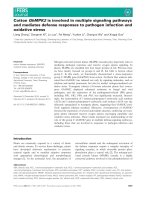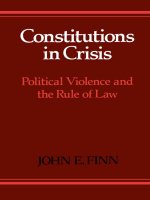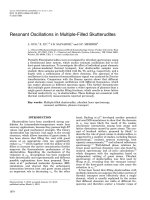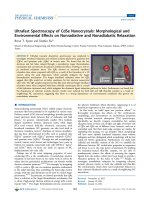coupled vibrational modes in multiple filled skutterudites and the effects on lattice thermal conductivity reduction
Bạn đang xem bản rút gọn của tài liệu. Xem và tải ngay bản đầy đủ của tài liệu tại đây (770.86 KB, 4 trang )
Coupled vibrational modes in multiple-filled skutterudites and the effects on
lattice thermal conductivity reduction
L. Guo, X. Xu, J. R. Salvador, and G. P. Meisner
Citation: Appl. Phys. Lett. 102, 111905 (2013); doi: 10.1063/1.4796121
View online:
View Table of Contents:
Published by the American Institute of Physics.
Related Articles
Nanowire-filled polymer composites with ultrahigh thermal conductivity
Appl. Phys. Lett. 102, 093117 (2013)
Thermal conductivity predictions of herringbone graphite nanofibers using molecular dynamics simulations
J. Chem. Phys. 138, 084708 (2013)
Cross-plane thermal properties of transition metal dichalcogenides
Appl. Phys. Lett. 102, 081604 (2013)
Thermoelectric properties of p-type (Bi2Te3)x(Sb2Te3)1−x single crystals doped with 3wt. % Te
J. Appl. Phys. 113, 073709 (2013)
Effect of grain boundaries on thermal transport in graphene
Appl. Phys. Lett. 102, 033104 (2013)
Additional information on Appl. Phys. Lett.
Journal Homepage:
Journal Information:
Top downloads:
Information for Authors:
Downloaded 19 Mar 2013 to 128.46.221.60. Redistribution subject to AIP license or copyright; see />Coupled vibrational modes in multiple-filled skutterudites and the effects
on lattice thermal conductivity reduction
L. Guo,
1
X. Xu,
1,a)
J. R. Salvador,
2
and G. P. Meisner
2
1
School of Mechanical Engineering and Birck Nanotechnology Center, Purdue University, West Lafayette,
Indiana 47907, USA
2
Chemical and Materials Systems Laboratory, GM Global R&D, Warren, Michigan 48090, USA
(Received 14 January 2013; accept ed 7 March 2013; published online 19 March 2013)
The influence of guest atoms on thermal conduction in filled skutterudites was studied using
ultrafast reflectance spectroscopy. Different filling species cause coupled vibrational modes
between the guest atoms and the host lattice at different frequencies, which scatter phonons in
different spectral spans. Using a Debye model for the measured lattice thermal conductivity
together with the measured vibration frequencies and scattering rates, it is shown that scattering
due to the coupled vibrational modes has a considerable contribution to the suppression of
lattice thermal conduction. This demonstrates that filling with multiple species can efficiently
reduce the lattice thermal conductivity in skutterudites.
V
C
2013 American Institute of Physics.
[ />Skutterudites have attracted much attention as a high tem-
perature thermoelectric material due to their high figure of
merit (ZT) in the temperature range from about 300
Cto
550
C.
1–3
It has been discovered that filling the void in the
skutterudite lattice structure with guest atoms can significantly
reduce the lattice thermal conductivity j
L
and improve the
thermoelectric figure of merit.
4–7
Many studies have been con-
ducted to elucidate the mechanism of this phenomenon, and
different viewpoints have been proposed. The concept of
localized rattlers
8
for the role of guest atoms is supported by a
number of studies including Raman spectroscopy,
9
inelastic
neutron scattering, heat capacity measurements,
10,11
and infra-
red reflectance spectroscopy.
12
However, molecular dynamics
(MD) simulations showed that anharmonic interactions
between host and guest atoms were important for decreasing
j
L
.
13
Another MD studies explained the lower j
L
as a result
of lattice distortions and weaker interatomic interactions
among host atoms due to filling atoms.
14
Using neutron spec-
troscopy and ab initio calculations, it was found that well-
defined phase relations between guest and host dynamics
existed,
15
which also contradicted the concept of independent
rattlers. Therefore, there is still a controversy on the mecha-
nisms of thermal conductivity reduction in filled skutterudites.
It has also been proposed to fill the skutterudite crystal
structure with more that one species of guest atoms in order
to scatter a broader range of phonons.
6,7
Recently, ultrafast
spectroscopy was carried out successfully to study the inter-
actions between the host lattice and the guest atoms in
p-type misch-metal filled skutterudites
16
and n-type filled
skutterudites.
17
In this work, we investigate the details of the
interactions between the filled elements and the phonons in
single and multiple filled skutterudites. These studies allow
determination of the effect of filling skutterudites with multi-
ple elements and the role of coupled vibrations in thermal
conductivity reduction.
Three single-filled n-type samples with individual ele-
ment and one triple-filled n-type sample with all the three
elements were used. The compositions of these samples
were determined to be Ba
0.26
Co
4
Sb
12.01
,Yb
0.21
Co
4
Sb
11.92
,
La
0.14
Co
4
Sb
11.99
, and Yb
0.05
La
0.05
Ba
0.08
Co
4
Sb
11.92
from
electron probe microanalysis. Ultrafast spectroscopy for
measuring the interactions between the host lattice and guest
atoms is based on femtosecond time-resolved pump-probe
technique to measure the transient reflectance of the samples
irradiated by femtosecond laser pulses.
16
The femtosecond
laser pulses were generated from a Spectra Physics
Ti:sapphire amplified laser system with a central wavelength
of 800 nm and a repetition rate of 5 kHz. A barium borate
(BBO) crystal was used to convert the wavelength of the
pump pulses to 400 nm. The probe and the pump had pulse
durations (full width at half maximum (FWHM)) of 70 fs
and 140 fs, respectively. Raman spectra of the samples were
also measured to identify lattice-vibration modes.
The transient reflectance signals of the samples have
similar features. Fig. 1 shows the signal of the La-filled sam-
ple, where the inset illustrates the oscillation in a magnified
scale. The signal features are different from those of the p-
type misch-metal-filled skutterudites for which part of the
Co is substituted by Fe to stabilize the skutterudite phase.
16
First, the background signals of these n-type skutterudites
have an initial drop instead of a rise, which indicates differ-
ent carrier dynamics in these samples compared to p-type
skutterudites. As predicted by density-functional band-struc-
ture calculations,
18
guest atom fillers tend to raise the Fermi
level into the conduction band while substitution of Co by Fe
moves the Fermi level down across an area of a low density
of states towards the valence band. Second, the oscillations
are much weaker, and there are several reasons for this. The
first is the much lower filler concentrations used in these
samples ($10%–20%) compared with previously investi-
gated misch-metal filled samples (55%–82%).
16
The second
is the n-type samples in the present study have smaller effec-
tive carrier mass, which weakens the carrier-lattice coupling
a)
Author to whom correspondence should be addressed. Electronic mail:
0003-6951/2013/102(11)/111905/3/$30.00
V
C
2013 American Institute of Physics102, 111905-1
APPLIED PHYSICS LETTERS 102, 111905 (2013)
Downloaded 19 Mar 2013 to 128.46.221.60. Redistribution subject to AIP license or copyright; see />in terms of excitation of atomic vibration. The third is related
to the different electronic band structures. Modulation of the
optical signal by lattice vibration is generally most promi-
nent when the probe is at the spectrum range where the slope
of the absorption spectrum is large.
19
The difference in elec-
tronic band structures will change the absorption/reflection
spectrum, which changes the sensitivity of the probed state
to the lattice vibration.
In order to identify the detected oscillation modes, a
second-order Butterworth bandpass filter was applied to
remove the background carrier signal, and then a Fourier
transform was performed to analyze the spectra of the oscil-
lations, as shown in Fig. 2, with dominating peaks marked
by the vertical dashed lines. The peaks at 174 cm
À1
exist for
all the samples which is one of the F
g
modes
20,21
that
involves motions of the Sb atoms but is not related to the fill-
ing atoms.
21
The peaks in the range between 146 and
155 cm
À1
change with the filler species. For the triple-filled
sample, there are two peaks in that range. The Raman spectra
of all the samples are similar with regard to the positions of
the Raman peaks, and the only detected mode near 147 cm
À1
is the low-energy A
g
mode, which is one of the breathing
modes of the Sb
4
ring. The frequencies of the low-energy A
g
modes from Raman spectroscopy are 145.8 cm
À1
,
147.7 cm
À1
, 147.5 cm
À1
, and 147.7 cm
À1
for the Ba-filled,
Yb-filled, La-filled, and triple-filled samples, respectively.
Compared with Fig. 2, it is clear that the oscillations
observed in the transient reflectance measurements are
shifted from the low-energy A
g
mode. These oscillations are
caused by the filling atoms and the coupling between the fill-
ing atoms and the host lattice vibration. They are not phonon
modes since a phonon mode would be observed in Raman
spectroscopy. In the skutterudites with low filling ratio,
moreover, there will be no translation symmetry or periodic-
ity of a host-guest structure. Figure 2 also shows that Yb and
La generate coupled vibrational modes with close frequen-
cies but different from the mode frequencies produced by
Ba. The oscillation spectrum for the triple-filled sample
includes two frequencies with one close to the frequency
caused by Yb or La and the other close to that caused by Ba.
We thus see that filling the skutterudite crystal structure with
different elements causes different frequencies for the host-
guest system.
To evaluate the contribution of the coupled modes to the
thermal conductivi ty reduction, we obtain the lattice thermal
conductivity from the total thermal conductivity using
Wiedemann-Franz relation (Lorenz number set equal to
2.0 Â 10
À8
V
2
/K
2
) and take the model based on the Debye
approximation to fit the measured results from 4 K to
300 K
22,23
k
L
¼
k
B
2p
2
v
k
B
T
h
3
ð
h
D
T
0
x
4
e
x
dx
s
À1
ðe
x
À 1Þ
2
; (1)
where x ¼ hx/k
B
T, h is the reduced Planck constant, x is the
phonon angular frequency, k
B
is the Boltzmann constant, and
T is the temperature. The sound velocity v and the Debye
temperature h
D
are 2700 m/s and 287 K, respectively.
23
The
phonon relaxation time s is given by
s
À1
¼
v
L
þ Ax
4
þ Bx
2
Texp À
h
D
3T
þ
1
s
0
exp À
ðx À x
0
Þ
2
x
b
2
"#
;
(2)
where L represents the average grain size and x
0
is the fre-
quency of the coupled mode determined experimentally. The
four terms in Eq. (2) represent scattering by grain boundary,
point defects, phonon-phonon Umklapp processes, and the
coupled mode, respectively. Unlike the rattling mode, which
FIG. 1. Transient reflectance of the La-filled sample (magnified in the inset).
FIG. 2. Normalized transient reflectance spectra (the curves were vertically
shifted for clarity).
FIG. 3. Comparison between measured and fitted lattice thermal conductivity.
111905-2 Guo et al. Appl. Phys. Lett. 102, 111905 (2013)
Downloaded 19 Mar 2013 to 128.46.221.60. Redistribution subject to AIP license or copyright; see />is associated with random and independent motions of the
filling atoms, the coupled mode involves phase-matched rel-
ative motions of the host lattice and the filling atoms and dis-
turbs phonon transport by scattering. The relaxation time s
0
(or the inverse of the scattering rate) was determined experi-
mentally from the decay of the oscillation in the transient
reflectance signal as a damping oscillator.
24,25
We further
assume that the coupled mode also scatters phonons at fre-
quency other than x
0
, with a spectral dependence of a
Gaussian form and a bandwidth of x
b
. The variables L, A, B,
and x
b
are fitted to the experimentally measured thermal
conductivity. The fitting results for the lattice thermal con-
ductivity are shown in Fig. 3, and the parameters used are
listed in Table I. For the triple-filled sample, two resonance
terms are used. Good fitting can be obtained except for devi-
ations at higher temperature, which is attributed to the radia-
tion loss that affects the measured thermal conductivity.
22
We then evaluate and compare the contribution of each
scattering term at the frequency x
0
and 300 K, which is
shown in Fig. 4 . For the triple-filled sample, the low-
frequency term is used. It is seen that the boundary scattering
contributes the least at this temperature, and the other three
terms have comparable magnitudes, indicating that the
coupled vibrational mode has a considerable influence on the
lattice thermal conductivity. For the triple-filled sample, the
existence of two resonant terms increases the effect on the
lattice thermal conductivity reduction.
In summary, ultrafast spectroscopy shows oscillations
in single- and triple-filled skutterudites caused by filling
the skutterudite host crystal structure with guest atoms.
Comparison of the oscillations with the Raman spectrums
indicated that the detected oscillations represent the coupled
vibrational mode of the host-guest system, while filling with
different elements produces different vibrational frequencies.
Using a lattice thermal conductivity model together with
measured vibrational frequencies and scattering rates, it is
shown that the coupled vibrational mode has a considerable
contribution to the reduction of the lattice thermal conductiv-
ity and that multiple-element filling can effectively suppress
phonon-mediated thermal conduction in skutterudites.
Support for this work comes f rom the National Science
Foundation (Award No. 1048616) which is gratefully acknowl-
edged. The work a t GM is supported by GM and by DOE
under Corporate Agreement No. DE-AC05000OR22725.
1
G. S. Nolas, D. T. Morelli, and T. M. Tritt, Annu. Rev. Mater. Sci. 29,89
(1999).
2
H. Kleinke, Chem. Mater. 22, 604 (2010).
3
W. S. Liu, X. Yan, G. Chen, and Z. F. Ren, Nano Energy 1, 42 (2012).
4
G. P. Meisner, D. T. Morelli, S. Hu, J. Yang, and C. Uher, Phys. Rev. Lett.
80, 3551 (1998).
5
G. S. Nolas, H. Takizawa, T. Endo, H. Sellinschegg, and D. C. Johnson,
Appl. Phys. Lett. 77, 52 (2000).
6
X. Shi, J. Yang, J. R. Salvador, M. F. Chi, J. Y. Cho, H. Wang, S. Q. Bai,
J. H. Yang, W. Q. Zhang, and L. D. Chen, J. Am. Chem. Soc. 133, 7837
(2011).
7
X. Shi, H. Kong, C P. Li, C. Uher, J. Yang, J. R. Salvador, H. Wang, L.
Chen, and W. Zhang, Appl. Phys. Lett. 92, 182101 (2008).
8
G. A. Slack, in CRC Handbook of Thermoelectrics, edited by D. M. Rowe
(CRC, Boca Raton, FL, 1995), p. 407.
9
L. X. Li, H. Liu, J. Y. Wang, X. B. Hu, S. R. Zhao, H. D. Jiang, Q. J.
Huang, H. H. Wang, and Z. F. Li, Chem. Phys. Lett. 347, 373 (2001).
10
V. Keppens, D. Mandrus, B. C. Sales, B. C. Chakoumakos, P. Dai, R.
Coldea, M. B. Maple, D. A. Gajewski, E. J. Freeman, and S. Bennington,
Nature (London) 395, 876 (1998).
11
R. P. Hermann, R. Y. Jin, W. Schweika, F. Grandjean, D. Mandrus, B. C.
Sales, and G. J. Long, Phys. Rev. Lett. 90, 135505 (2003).
12
S. V. Dordevic, N. R. Dilley, E. D. Bauer, D. N. Basov, M. B. Maple, and
L. Degiorgi, Phys. Rev. B 60, 11321 (1999).
13
N. Bernstein, J. L. Feldman, and D. J. Singh, Phys. Rev. B 81, 134301
(2010).
14
B. L. Huang and M. Kaviany, Acta Mater. 58, 4516 (2010).
15
M. M. Koza, M. R. Johnson, R. Viennois, H. Mutka, L. Girard, and D.
Ravot, Nat. Mater. 7, 805 (2008).
16
Y. Wang, X. Xu, and J. Yang, Phys. Rev. Lett. 102, 175508 (2009).
17
L. Guo, X. Xu, J. R. Salvador, and G. P. Meisner, “Resonant oscillations
in multiple-filled skutterudites” J. Electron. Mater. (in press).
18
O. M. Løvvik and Ø. Prytz, Phys. Rev. B 70, 195119 (2004).
19
D. M. Sagar, R. R. Cooney, S. L. Sewall, E. A. Dias, M. M. Barsan, I. S.
Butler, and P. Kambhampati, Phys. Rev. B 77, 235321 (2008).
20
G. S. Nolas and C. A. Kendziora, Phys. Rev. B 59, 6189 (1999).
21
J. L. Feldman, D. J. Singh, and C. Kendziora, Phys. Rev. B 68, 094301
(2003).
22
J. Yang, D. T. Morelli, G. P. Meisner, W. Chen, J. S. Dyck, and C. Uher,
Phys. Rev. B 67, 165207 (2003).
23
G. S. Nolas, G. Fowler, and J. Yang, J. Appl. Phys. 100, 043705 (2006).
24
A. Q. Wu and X. Xu, Appl. Phys. Lett. 90, 251111 (2007).
25
O. V. Misochko, M. Hase, K. Ishioka, and M. Kitajima, Phys. Rev. Lett.
92, 197401-1 (2004).
TABLE I. Fitting parameters for the lattice thermal conductivity. The parameters x
o
and s
o
are experimentally determined values.
Sample composition L/lm A/10
À43
s
3
B/10
À18
s/K x
0
/10
12
rad/s x
b
/10
12
rad/s s
0
/ps
Ba
0.26
Co
4
Sb
12.01
3.13 121.21 5.05 29.52 10.80 3.94
Yb
0.21
Co
4
Sb
11.92
4.34 298.99 2.45 27.63 8.85 2.93
La
0.14
Co
4
Sb
11.99
3.74 185.86 3.01 27.63 9.29 2.93
Yb
0.05
La
0.05
Ba
0.08
Co
4
Sb
11.92
4.22 230.30 4.13 27.00/28.89 9.36/8.85 2.53/1.92
FIG. 4. Comparison of each scattering term at the resonance frequency and
300 K.
111905-3 Guo et al. Appl. Phys. Lett. 102, 111905 (2013)
Downloaded 19 Mar 2013 to 128.46.221.60. Redistribution subject to AIP license or copyright; see />









